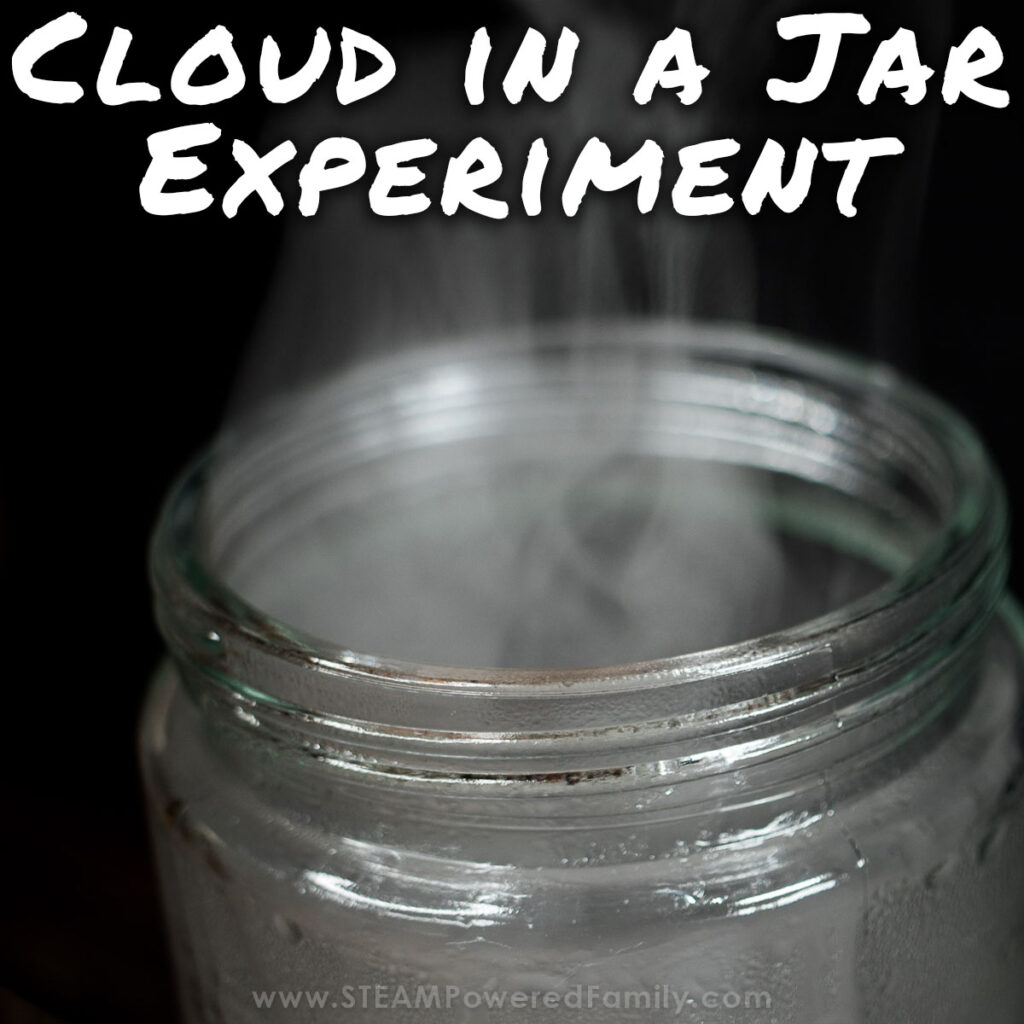Easy Cloud in a Jar Experiments
Growing up one of my favorite things to do was lay in the grass and stare up at the clouds. Cloud formation is a fundamental meteorological phenomenon that can seem quite mysterious, but it’s actually a really cool and accessible subject for students of all ages. Today, let’s dive into a simple classroom experiment that demystifies cloud formation: the Cloud in a Jar experiment. Not only is this experiment straightforward and easy to do, but it also teaches some fantastic weather science lessons that are sure to engage and educate your students.
Capturing a Cloud in a Jar: A Simple Experiment with Profound Science Lessons

Disclaimer: This article may contain commission or affiliate links. As an Amazon Influencer I earn from qualifying purchases.
Not seeing our videos? Turn off any adblockers to ensure our video feed can be seen. Or visit our YouTube channel to see if the video has been uploaded there. We are slowly uploading our archives. Thanks!
We love studying weather science. What is the number one small talk topic? The weather! We are always talking about the weather, which makes doing weather science experiments a fantastic way to bring real life into our science labs.
Today’s experiment is fast and easy. Making a cloud in a jar is one of those classic experiments that all students should do at least once.
SAFETY NOTE: This experiment is fun for all ages, however, use caution around matches. For younger students an adult should do this step. Always practice fire safety and have water, a fire extinguisher or wet cloths near by. For younger students you can do this experiment as a demonstration, while middle grade students can tackle this experiment under adult supervision.
Cloud in a Jar Video
Check out the video of this experiment to see how we did it. If you can’t see the video your adblockers or firewall are blocking our feed. You can also find this video, with closed captions, on the STEAM Powered Family YouTube Channel.
Making a Cloud in a Jar
We tried this experiment three different ways. By doing it three different ways we were able to compare the different techniques and learn different lessons.
Cloud in a Jar Experiment #1
Materials
A tall clear glass jar with a lid (It is best if it has smooth sides, it makes it easier to see the clouds form.)
Hot water (tap hot is perfect, not boiling)
Ice cubes
Matches
Directions
Pro Tip! Set up the experiment against a dark background, it makes it easier to see the clouds form.
Prepare the Jar
Begin by pouring about two inches of hot water into the clear glass jar. The water should be hot but not boiling, ideally around 60°C (140°F) to create enough warm vapor.
Light It Up
After the hot water is in the jar, quickly strike a match, let it burn for a few seconds, and then drop it into the water. Immediately replace the lid. This step should be handled by the teacher or with close supervision if older students are conducting the experiment.
Chill It
Place a few ice cubes on top of the jar lid. The contrast between the hot air inside the jar and the cold lid will intensify the experiment’s effects.
Watch the Cloud Form
Instruct your students to observe the jar closely. Within a few minutes, a small cloud will form in the upper part of the jar.
What we found really fascinating was that if you watch closely (look in our video and you can see it), you can see the cloud moving up and down in the jar. As it cools at the top it starts to fall down, then at the bottom it warms and goes back up. It was really neat to see this!
Release the Cloud
After observing the cloud, remove the lid and watch as the small cloud escapes into the air of the classroom. This is a fun way to finish the experiment.

Cloud in a Jar Science Notes
The Cloud in a Jar experiment is an excellent demonstration of the water cycle, specifically the process of condensation and cloud formation. So let’s dive into the science and some vocabulary for our students to really understand what they are seeing.
Evaporation
The hot water in the jar evaporates quickly, turning into water vapor, which is the gaseous state of water. This vapor rises due to the heat, filling the upper parts of the jar. You will see some condensation on the sides of the jar. If there is too much condensation it can be hard to see the cloud that forms. To fix this issue, use slightly cooler water. The higher the temperature of the water, the more water vapor it will produce.
Condensation Nuclei
When the match is struck it introduces smoke particles into the jar. These tiny particles act as condensation nuclei. In the real world, dust, pollen, and other pollutants serve this purpose, providing surfaces onto which water vapor can condense.
Fun Fact! In some countries they use a scientific process called Cloud Seeding, where condensation nuclei are introduced into the atmosphere as a way to try and control the weather and increase precipitation.

Condensation
As the warm, moist air rises and encounters the cold lid (chilled by the ice), the temperature of the vapor drops. When it cools below its dew point, the vapor condenses around the smoke particles, forming tiny droplets of liquid water. These droplets cluster together around each smoke particle, forming a visible cloud.
This experiment is a small-scale model of what happens in the atmosphere all over the world, every day. Clouds in the sky form when warm air rises, expands, and cools, leading to condensation on particles in the air.
Cloud in a Jar Experiment Alternative Technique
The above experiment is a classic way to make a cloud in a jar and in our experience the most effective, however there is another approach you can take that takes into consideration the role of air pressure and temperature on cloud formation. We have explored air pressure and the weather with our DIY Barometer project. This experiment is perfect for your middle school and high school students or for the science fair.
Instead of ice, we are going to use a balloon on the top of our jar this time.
First, trim the bottom off of a balloon and make sure it fits nicely over the top of your jar. Ensure you leave enough of the balloon that it stays on the jar securely when you press down on the top. I had to scale down to a smaller jar than the one I used for the first cloud in a jar experiment to find one that fit my balloon.
Now take your jar and fill it about a 1/4 full with warm water.
Light a match, blow it out, and drop it into the jar.
Now quickly place the balloon over the top of the jar.

Invite your students to get close. You will want to add some light so you can really see what is going on with this next step. Aiming a flashlight at the jar works great. Gently press down on the balloon, then release. Watch inside the jar. You will see clouds form in the jar as you change the air pressure by pressing down on the balloon and releasing it. The video we shared earlier in the article really shows this!
Science Behind Experiment #2
The second experiment is a fantastic demonstration of how air pressure, temperature, and volume are interrelated (as described by the Ideal Gas Law) and how these factors influence cloud formation.
Let’s explore the Ideal Gas Law. According to the ideal gas law (PV = nRT), as temperature (T) increases, the pressure (P) also tends to increase if the volume (V) is constant.
By using warm water, you increase the temperature of the air inside the jar.
When you press and then release the balloon, you first decrease the volume of the air (pushing the balloon in), which increases the pressure. Releasing the balloon suddenly increases the volume and drops the pressure.
The rapid expansion (when the balloon is released) causes the air inside the jar to cool quickly. The cooler air can hold less water vapor, and the excess vapor condenses into tiny water droplets around small particles in the air from the match smoke. This condensation forms a cloud in the jar.
You can also play with this science in our Crush a Bottle experiment. Plus Crash Course has a great video explaining Ideal Gas Law.
This experiment mirrors what happens in the atmosphere when we experience pressure changes. When warm air rises, it expands due to lower atmospheric pressure at higher altitudes, cools, and if conditions are right, the moisture it carries condenses into clouds.
Cloud in a Jar with Hairspray
Another way you can do this experiment is with hairspray or some other type of aerosol spray. If you watch our video, we tried this technique too. We didn’t have hairspray, so we used an aerosol air freshener. The science is the same as the first experiment, introducing condensation nuclei, but instead of match smoke we are using aerosol particles.
Have your students test the different cloud in a jar methods to see which ones they like the best.
Extension Activities
Discuss the roles of evaporation, condensation, and condensation nuclei in the water cycle. Check out our Water Cycle Activity.
Explore how cloud formation varies with different weather conditions. What do you think causes the different types of cloud formations?
Take what we learned today and talk about environmental science by discussing the impact of air pollution on cloud formation. Explore pollution even more, with this water pollution experiment.
Creating a cloud in a jar is one of those classic experiments that always creates a sense of awe in students. Kids absolutely love this science and it will make them look at the skies in a whole new way. If you want to explore more about rainfall and clouds, try this Rainbow Rain Experiment. It is another simple science experiment that demonstrates how rain falls from the clouds.
Who knew the weather could be so fascinating?! Check out more really exciting Weather Science Experiments in this resource.



